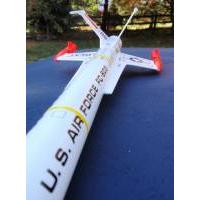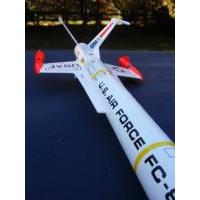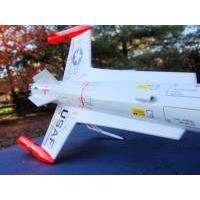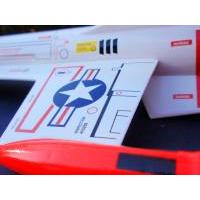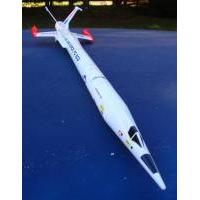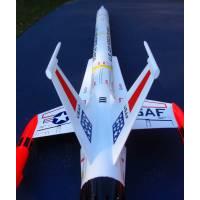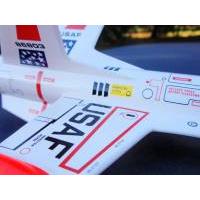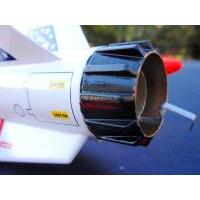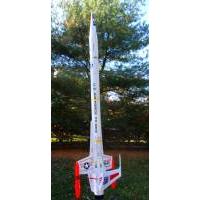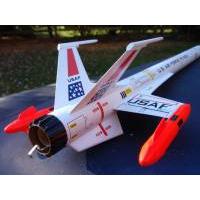| Construction Rating: | starstarstarstar_borderstar_border |
| Flight Rating: | starstarstarstar_borderstar_border |
| Overall Rating: | starstarstarstarstar_border |
| Published: | 2012-06-08 |
| Diameter: | 1.30 inches |
| Length: | 26.00 inches |
| Manufacturer: | Estes  |
| Skill Level: | 2 |
| Style: | Futuristic/Exotic |
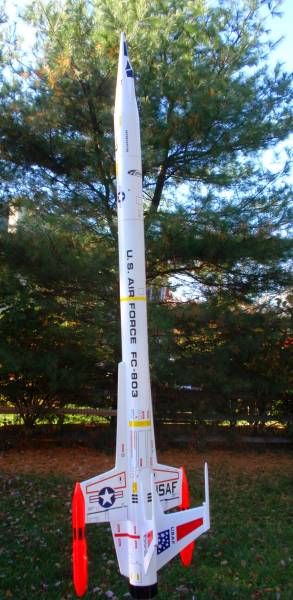 Brief
Brief
Estes re-issue of the original Interceptor. This flies using standard sized 18mm motors. Any other description of this model would be fruitless - just take a look at the photographs showing the design of the rocket and the decals - that pretty much says it all.
This is not an easy kit to build, you should have some practice gluing and finishing balsa fins before attempting this model, overall it is more work than a basic rocket but not too challenging for an experienced modeler.
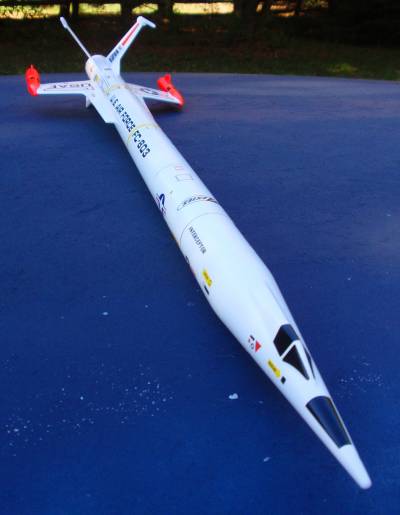
Components
Every component I got from this Estes kit was flawless, except that shock-cord mount of course. I instead used a bit of Kevlar anchored to a Sunward ejection baffle, and tied the rubber shock cord to the Kevlar. The Kevlar was sized just small enough to not reach the end of the body tube, so it couldn't zipper-damage the tube end. The body tube, balsa fins/wings, motor mount, decal sheets, and molded plastic parts were all very good quality. The white plastic parachute was reasonably thick, but it was totally destroyed on it's first flight. That is of course my fault and that is a whole 'nuther story.
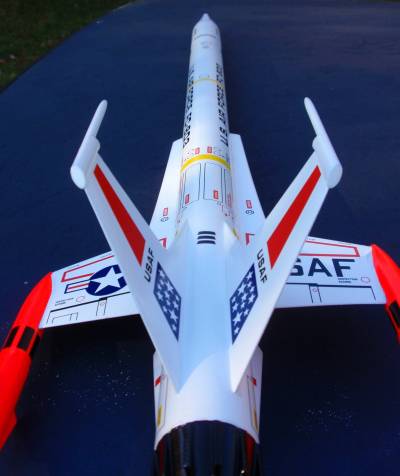
Construction
The intstructions were very good. In hindsight, I would have liked the engine mount to protrude out the back about a 1/4 inch or so, for easier insertion/removal and to prevent soot buildup or burning of the plastic tailcone. The only way to do that is to glue the rear centering ring onto the engine tube slightly more forward, because the plastic ring of the tailcone prevents one from mounting the engine in any further back than originally designed. Also a small issue not covered by the instructions: The plastic antennas that are on top of the rudders have a slot that goes over the balsa of the rudders. The slots were a bit too long. I don't know for sure if I over-sanded the trailing-edge taper of the rudders or if Estes just missed the dimensions on this, but it's something you should look out for when building the rudders. Also, make extra-sure you put all the fins on correctly front/back-wise, I came real close to gluing them on backwards, and I saw somebody else did too. Everything else on this model seemed to be flawless construction-wise.


Finishing
Finishing should have been easy, but somehow it was a lot of trouble for me, but I can't blame Estes for that. That was all my fault.
Sanding the finished model can be a bit challenging, because of all the fins, wings and antenna's and pods make it harder to get a sanding block and your fingers in the tight spots. I made some "special-shaped" sanding blocks to help me with the process, and it's a good thing because I had a LOT of sanding to do (read further and understand why).
I decided to spray paint the tailcone seperately before gluing it on as Estes suggested, that worked fine. But I should have finished and sanded the entire model before attaching it. Since I didn't, I had several sandpaper vs. tailcone paint issues, where the sandpaper won, which left occasional spots of white plastic where the black paint was removed. Glue it on AFTER ALL the sanding is done. I did remember to mask off the inside body tube area and the outside of the tailcone where the glue was to be applied. This important detail was NOT mentioned in the instructions.
Using that same logic, I decided to spray paint the wing pods before gluing them on. That turned out to be big problem #1. First, I missed painting part of the exterior of the wing pods because BOTH sides of the plastic pieces have exposed white plastic. I accidentally glued them to the rocket before I noticed it. That mistake cost me an extra step masking and spraying the pods after they were attached to the white rocket.
Compounding the problem, I thought I was being smarter by not gluing the two plastic halfs together until after gluing the one half to the wings. I thought ahead and masked off the wing tip balsa where the glue was to be applied, so there was no balsa fillercoat or primer or paint on the wing tips. This allowed me to get a really, really good glue joint because I used a seperate combination of plastic glue, wood glue to different parts of the surfaces to be joined. On top of that, I used epoxy. ONE of those three glues should hold! That part worked well, but what I didn't figure out at the time was this: The alignment of the plastic pod assemblies to the wing tips is aided by the internal geometry of both pieces of plastic. I didn't have that and discovered it was difficult to align the inner half only while attaching it to the wing. The other problem was that when I finally did glue the two pod half pieces together, they did not fit exactly, I had to cut away some of the plastic inside the pod. Minor problem, a little plastic putty and some light sanding fixed that. But since my wing pods were painted already, the green putty made a cosmetic mess of the finish. The flourescent orange spray paint (Testors) I used was very transparent to this green putty when I tried to paint over it, so I had to mask, prime and then re-paint (a third time) the pods with them attached to the rocket already.
But that wasn't the worst finishing problem for me. Problem #2: Trying to use a cheaper Rustoleum primer, paint and clearcoat. I sanded the model to perfection. After two or three coats of balsa fillercoat I sanded to perfection again. I applied two coats of primer and sanded lightly between coats. Then I went to the white Rustoleum "2X" paint. The surface of the rocket looked really good, but not for a rocket. The entire surface came out with a rough, "orange peel" type of finish, which was quite awesome by itself - but considering the decals I had to add and the desire for a smooth, low-drag finish, it would not do. I totally sanded off the finish and tried again, maybe I was spraying it on too thick, but I didn't have any runs on the model. Second time around: just as rough. So I sanded it all off again, and probably much of the primer with it.
Meanwhile with another rocket, using the same paint brand, I sprayed it on too thick - ordinary paint would have run all over the place - but with this, the thickly sprayed areas came out to a smooth, glossy finish, while the lightly sprayed areas were rough and orange-peel-y. On that model, I emptied almost a whole can of paint and the finish is awesome - but the rocket weights something like a brick now.
With that lesson learned, I then sprayed the Interceptor with a thick coat of Rustoleum 2X paint, this time the finish was good, but the model was certianly heavy now. I don't know exactly why, but for some reason I wanted to put a clearcoat on the rocket before applying decals, and I'm glad I did. I sprayed a moderate layer of Rustoleum (same brand) clearcoat on the model and left it to dry. The next day, to my horror, the finish krickled up in places and cracked down to the primer. The finish was basically ruined in places.
OK, so I had to sand off the damaged areas of the wing and body tube and try again. This time I ditched the Rustoleum stuff and used the expensive Testor's model paint. The white color didn't match, and the cracks still came through. So yet another sanding, this time down to the balsa or paper and then some, before painting the entire model with Testor's paint. In the process I gouged several areas of the balsa and could never get it to be as smooth as desired. But at least the entire model was white, smooth and glossy, even if it weighed just shy of a sumo wrestler.
The next problem I had should have been obvious to an experienced modeler. I wanted to avoid the masking/painting process between the white wings and the orange pods. But when I had them attached, of course the fit wasn't perfect, and I had to add some epoxy filler between the two (which I intended to do anyways to make sure they didn't break off). The net result: I had to paint over the epoxy fillets anyway. Of course Mr. Murphy's rules applied: When brushing some white paint on over the orange areas, it seemed to disolve the orange pigment and instead of white paint, I was spreading pink paint all over. It took several tries of light coats and long drying times to get a reasonable edge between the white and orange paint.
Again - all this finishing trouble is not at all Estes fault - just my own bad luck. The model was excellent, and I was just trying to finish it with an equally excellent paint job. But I did learn a few lessons for you:
1) Glue the plastic pods together and fill and finish them first before attaching them to the completely finished wings. Or just glue them on before painting, fillet them, paint it all white and then mask and paint them whatever color you like after everything else is painted.
2) Don't try to save money and use the Home Depot's 2X paint - your rocket will weigh too much or be all krinkly looking. I went back to using Testor's paints, it's very expensive, but it makes an excellent finish when it's all done, and is rather lightweight.
3) Glue the tailcone AFTER all the other sanding and painting is done, but don't forget to mask the glue surfaces first.
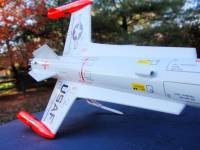
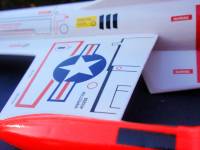
Flight
This model would have flown well, except that it was way overweight. Compounding the paint issue, I added an ejection baffle and a 3-inch long altimeter bay to the model. This put it way over the top. String-testing for stability required me to add yet another 17 grams of noseweight to get it to swing well. This was now at about 150% of the recommended max weight of the C6-3 motor, but I gave it a try anyway. Liftoff was too slow, winds were somewhat strong, and the model weather-cocked to a horizontal flight at about 200 feet or less. Ejection seemed OK though and when I saw the parachute open, I looked away and started my walk. When I arrived at the landing site, I was amazed to find ALL SIX parachute shrouds ripped from the parachute and a few random tears in the plastic. The knots held, but the plastic was just shredded by the force of the wind. That same day I saw a buddy's stock Interceptor fly perfectly well on a C6-3 motor, same day, same winds, same temperature, so it most certianly is a result of my "personal weight problem". I'm going to do two things: 1) Try a D10-5 motor on this - which should thrust it to well over 500-600 feet, and using a new nylon parachute it should recover well. Later, I'm going to remove the 17 gram noseweight and the altimeter bay and see if that noseweight was really necessary for a C6-3 motor. Assuming that works fine, I'll re-add the altimeter bay and give it another test flight - of course I'll warn everybody there to be on the lookout for a out-of-control rocket.
It did fly well with an 18mm Apogee (Aerotek) D10-5 motor. The delay was near perfect. It reached an apogee of just under 700 feet and the trajectory was straight as an arrow. The powerful motor had an equally strong ejection charge, which blew through the Sunward ejection baffle like it wasn't even there, burning a large hole in the brand-new Nylon parachute. Knowing that it is capable of flying well, the third test will be to reduce the nose weight a bit (maybe 8 instead of 17 grams), remove the payload section and try another C6 motor. The results of further testing will be added to the comments below.
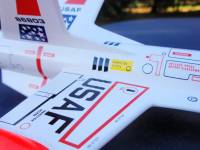

Recovery
The supplied parachute seemed OK, and was a good diameter for this rocket, but mine was shredded from ejecting a bit late. I usually prefer changing out all my chutes to nylon anyway as soon as they give me trouble. I can understand the cost reasons, but plastic parachutes are not so reliable in cold or in excess strength. On heavier models though, plastic is a good way to reduce weight.

Summary
In spite of my troubles with this model caused by me only, it really is a great design and the parts quality was excellent - almost perfect. (Perfect would be a Kevlar shock cord and a nylon parachute, and better dimensions on the rudder-tip antennas or whatever they are).
Other Reviews
- Estes Interceptor By Todd Mullin (July 3, 2008)
From the year 1971 until 1980 Estes produced the original version of the Interceptor. It is considered by many to be the quintessential kit of model rocketry's "Golden Age". Many online auctions for the original sealed kits can go up to hundreds of dollars! Fortunately for those of us who are fans of the futuristic design but without a huge bankroll Estes finally re-released a new version of the ...
- Estes Interceptor (1250) By John R. Brandon III (March 7, 2008)
Brief: This is a single_stage futuristic "aerospace fighter" with 18" parachute recovery. Construction: The kit consists of: 33mm Estes BT-55 body tube 18mm Estes motor mount tube 2 cardstock centering rings A cardstock thrust ring A metal motor-retainer hook 2 laser-cut fin sheets to make six fins 2 large wings 2 vertical ...
 |
 |
Flights
Sponsored Ads
 |
 |
